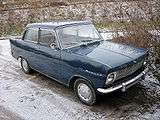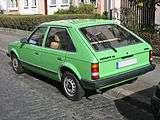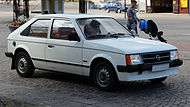Opel Kadett
| Opel Kadett | |
|---|---|
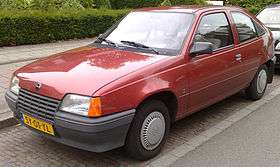 | |
| Overview | |
| Manufacturer | Opel (General Motors) |
| Production |
1937 – 1940 1962 – 1993 |
| Body and chassis | |
| Class | Small family car (C) |
| Chronology | |
| Predecessor | Opel 1.3 litre |
| Successor | Opel Astra |
The Opel Kadett is a small family car produced by the German automobile manufacturer Opel between 1937 and 1940, and then again from 1962 until 1991 (the Cabrio continued until 1993), when it was replaced by the Opel Astra.
Kadett I (1936–1940)
| Kadett I | |
|---|---|
 Opel Kadett Spezial (K38) "Cabrio-Limousine" (1939) | |
| Overview | |
| Production | 1936 – 1940 |
| Assembly | Rüsselsheim, Germany |
| Body and chassis | |
| Layout | FR layout |
| Related | Moskvitch 400/420 |
| Powertrain | |
| Engine | 1,074 cc sv I4 |
| Transmission | 3-speed manual |
| Dimensions | |
| Wheelbase | 2,337 mm (92.0 in) |
| Length | 3,765 mm (148.2 in)-3,840 mm (151.2 in) |
| Width | 1,375 mm (54.1 in) |
| Height | 1,455 mm (57.3 in)-1,545 mm (60.8 in) |
| Curb weight | 757 kg (1,669 lb) |
The first Opel car to carry the Kadett name was presented to the public in December 1936 by Opel's Commercial-Technical director, Heinrich Nordhoff, who would in later decades become known for his leadership role in building up the Volkswagen company.
The new Kadett followed the innovative Opel Olympia in adopting a chassis-less monocoque construction, suggesting that like the Vauxhall 10 introduced in 1937 by Opel's English sister-company, the Opel Kadett was designed for high volume low cost production.
-

Opel Kadett (1937–1940)
-
Opel Kadett Strolch (1938)
-
Opel Kadett "Limousine" "series 11 234", with the 1937 front. The grill was restyled for 1938.
-

Moskvitch 400 (1947–1954)
Kadett series 11 234 (1937)
For 1937 the Kadett was offered as a small and unpretentious[1] two door "Limousine" (sedan/saloon) or, at the same list price of 2,100 Marks, as a soft top "Cabrio-Limousine". The body resembled that of the existing larger Opel Olympia and its silhouette reflected the "streamlining" tendencies of the time. The 1,074cc side-valve engine came from the 1935 Opel P4 and came with the same listed maximum power output of 23 PS (17 kW; 23 hp) at 3,400 rpm.[2]
The brakes were now controlled using a hydraulic mechanism. The suspension featured synchromous springing, a suspension configuration already seen on the manufacturer's larger models and based on the Dubonnet system for which General Motors in France had purchased the license. The General Motors version, which had been further developed by Opel’s North American parent, was intended to provide a soft ride, but there was some criticism that handling and road-holding were compromised, especially when the system was applied to small light-weight cars such as the Kadett.[3] By the end of 1937 33,402 of these first generation Kadetts had been produced.[4]
Kadett "KJ38" and "K38 Spezial" (1938–1940)
From December 1937 a modified front grill signalled an upgrade. However, the 1,074cc Opel 23 PS (17 kW; 23 hp) engine and the 2,337 mm (92.0 in) wheelbase were unchanged, and it would have taken a keen eyed observer to spot the difference between the cars for 1937 and those for 1938.[5]
The manufacturer now offered two versions of the Kadett, designated the "Kadett KJ38 and the "Kadett K38" the latter also being sold as the "Kadett Spezial". Mechanically and in terms of published performance there was little to differentiate the two, but the "Spezial" had a chrome stripe below the window line, and extra external body trim in other areas such as on the front grill. The interior of the "Spezial" was also better equipped. To the extent that the 300 Mark saving for buyers of the car reflected reduced production costs, the major difference was that the more basic "KJ38" lost the synchromous springing with which the car had been launched, and which continued to be fitted on the "Spezial". The base car instead reverted to traditional rigid axle based suspension similar to that fitted on the old Opel P4.
The base car was available only as a two-door "Limousine" (sedan/saloon). Customers looking for a soft-top "Cabrio-limousine" would need to specify a "Kadett Spezial". For the first time Kadett buyers, provided they were prepared to choose a "Kadett Spezial" could also specify a four-door "Limousine" (sedan/saloon) bodied car, priced at 2,350 Marks as against 2,150 Marks for a "Spezial Cabrio-Limousine" and 2,100 Marks for a two-door "Spezial Limousine".
In marketing terms the "Kadett KJ38" was intended to fill the niche that Opel had recently vacated with the departure of the Opel P4, but the KJ38, priced at 1,800 Marks, was more expensive than the P4 and its reduced specification left it with the image of a car for poor people (..Image des Arme-Leute-Autos..) at a time when economic growth in Germany was finally fostering a less minimalist approach to car buying.[4] The "Kadett K38 Spezial" fared better in the market place: in 1938 and again in 1939 it was Germany's top selling small car. By May 1941 the company had produced 17,871 "Kadett KJ38"s and 56,335 "Kadett K38 Spezial"s.[4]
Commercial
Competitive pricing led to commercial success, and Kadetts continued to be produced during the early months of the war: by the time production ended in May 1940, following intensification of World War II, 106,608 of these Opel Kadetts[6] had come off the assembly line at Opel's Rüsselsheim plant, which had been the first major car plant in Germany to apply the assembly-line production techniques pioneered by Henry Ford.
Soviet afterlife
After the war, Opel production facilities from Brandenburg an der Havel (trucks) were crated up together with the production line plant and tooling from the Rüsselsheim (cars) plant and transported to the Soviet Union, along with the drawings and plans for the Kadett, as part of a larger reparations package agreed upon by the victorious powers. From 1948, the prewar Kadett was manufactured as the Moskvitch 400/420 and continued to be produced, very little changed, on the edge of Moscow until 1956.
Kadett A (1962–1965)
| Kadett A | |
|---|---|
.jpg) | |
| Overview | |
| Production | 1962 – 1965 |
| Layout | FR layout |
| Powertrain | |
| Engine | 993 cc Opel OHV OHV I4 |
The Kadett was re-introduced in 1962, with deliveries beginning on 2 October, a little more than 22 years after the original model was discontinued in May 1940.[7] The new car (designated the Kadett A) was a small family car like its predecessor, although it was now available in 2-door saloon, 3-door estate ("Car-A-Van") and coupé versions.
|
Kadett B (1965–1973)
| Kadett B | |
|---|---|
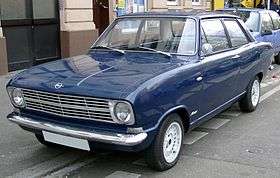 Opel Kadett B 2-door Limousine | |
| Overview | |
| Production | 1965 – 1973 |
| Body and chassis | |
| Related | Opel Olympia A |
The Kadett B was launched at the Frankfurt Motor Show in late summer 1965,[8][9] The Kadett B was larger all-round than the Kadett A: 5% longer both overall and in terms of the wheelbase, 7% wider and 9% heavier (unladen weight), albeit 10 mm (0.39 in) lower in basic standard "Limousine" (sedan/saloon) form.[10] Production ended in July 1973, with the successor model introduced a month later following the summer shut-down, in August. The two-seat Opel GT was heavily based on Kadett B components, its body made by a French contractor, Brissonneau & Lotz, at their Creil factory.
-
_cropped.jpg)
Opel Rallye Kadett B "Gills-coupé" ("Kiemencoupé"), 1965-70
-
Opel Kadett B body options
-
Opel Kadett B 4-door Limousine
-

Opel Kadett B Coupé "F" (1967-73)
-

Opel Kadett B "LS" Fastback sedan/saloon (1967-70)
-
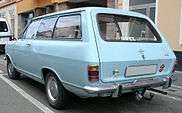
Rear-view of Opel Kadett B 3-door Caravan (Kombi) (1965-73)
Kadett C (1973–1979)
| Kadett C | |
|---|---|
 | |
| Overview | |
| Production | 1973 – 1979 |
| Dimensions | |
| Wheelbase | 2,395 mm (94.3 in) |
The Kadett C appeared in August 1973[11] and was Opel's version of the General Motors' "T-Car". It was the last small Opel to feature rear-wheel drive, and remained in production at Opel's Bochum plant until July 1979, by which time Opel had produced 1,701,076. Of these, 52% had been exported outside West Germany,[12] most of them to markets in other parts of western Europe.
-

Opel Kadett Coupé (1973–1977)
-
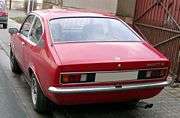
Rear
-
Opel Kadett Caravan (1973–1977)
-
Opel Kadett Coupé GT/E
-

Rear-view of Opel Kadett "City"
-
Opel Kadett C "Aero" (pre-1977 facelift)
-

Opel Kadett C 2 door "Limousine" (post-1977 facelift)
-

Opel Kadett C 4-door "Limousine"
Kadett D (1979–1984)
| Kadett D | |
|---|---|
 | |
| Overview | |
| Also called | Vauxhall Astra (United Kingdom) |
| Production | 1979 – 1984 |
| Assembly |
Bochum, Germany Antwerp, Belgium Ellesmere Port, England, United Kingdom |
| Body and chassis | |
| Body style |
3 and 5-door hatchback 2 and 4-door fastback 3 and 5-door wagon / estate (Caravan) |
| Layout | Transverse front-engine, front-wheel drive |
| Platform | T-platform |
| Related | Bedford Astravan (United Kingdom) |
| Powertrain | |
| Engine |
1.0 L Opel OHV I4 (petrol) 1.2 L Opel OHV I4 (petrol) 1.3 L Family 1 I4 (petrol) 1.6 L Family II I4 (petrol) 1.8 L Family II I4 (petrol) 1.6 L Family II I4 (diesel) |
| Transmission | |
| Dimensions | |
| Wheelbase | 2,514 mm (99.0 in) |
| Length |
3,998 mm (157.4 in) Caravan: 4,207 mm (165.6 in) |
| Width | 1,636 mm (64.4 in) |
| Height | 1,400 mm (55.1 in) |
| Curb weight | 875 kg (1,929.0 lb) - 1,060 kg (2,336.9 lb) |
The Kadett D was introduced in the middle of August 1979, with deliveries on the home market beginning early in September 1979.[13] In November 1979, the car went on sale in the United Kingdom, some five months before the Vauxhall Astra Mark 1, the British version, was launched in April 1980. The cars were designed as three- or five-door hatchbacks and estates or station wagons. There were also two- and four-door sedans featuring separate boots/trunks, which shared the silhouettes of the hatchbacks: in the United Kingdom, the sedan versions were soon withdrawn. For the first time, since 1965, there was no coupé bodied Kadett in the range: the previous Kadett C coupé was indirectly replaced by the three-door 1.3 SR sports model.
Technologically, the Kadett D was an departure, as it was Opel and Vauxhall's first front-wheel-drive car. It was also the first application of the Family II engine design, with an single overhead camshaft, aluminium-alloy cylinder head, hydraulic valve lifters, with capacities of 1297 cc (producing 60 PS and 75 PS) and had a transaxle design that allowed the clutch to be replaced without removing the transmission unit. A carry-over 1196 cc Opel OHV engine from previous generations of the Kadett producing 53 hp and a top speed of 87 mph was also offered on entry level models from launch,[14] and a new 1600 cc engine was offered after Frankfurt 1981, followed by an 1800 cc version introduced for the Kadett GSE/Astra GTE model. The Kadett D was also equipped with a 1600 cc diesel engine, an option which was first presented at the Brussels Motor Show in 1982.[15] Another frugal model, mostly sold in Italy, was the 1.0 liter model with 50 PS (37 kW).
This range of engines was also used for later models of the Corsa/Nova, and the mid-sized Cavalier/Ascona. From May 1981, the 1.3 was also available with a three-speed automatic. The automatic was made available to the diesel in September 1982. In Sweden, an special postal Kadett ("Opel Kadett Post") was offered, fitted with a high roof (necessitating a unique and much taller windshield) and a sliding right-hand door, RHD, and the automatic transmission.[16] This version was converted by Karosseriefabrik Voll (German) in Würzburg, Germany. Voll also made a postal version of the Kadett E.
It was also produced as IDA Kadett in Kikinda, Yugoslavia.
|
South Africa
The Opel Kadett D was also built in South Africa by General Motors South African (Pty) Ltd. The South African range was made up of four-door fastback sedans, five-door hatchbacks, and a five-door estate model called the Voyage.[17] The engines used are Opel's 1.2 litre overhead valve inline-four (L models only), or the OHC 1.3 liter (GL, GLS, and Voyage). Power is 60 PS (44 kW) and 75 PS (55 kW) respectively.[17] Later a 1.6 liter engine was added.
Kadett E (1984–1991)
| Kadett E | |
|---|---|
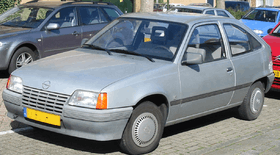 Pre-facelift Kadett 1.3 LS (1987) | |
| Overview | |
| Also called |
Opel Astra (East Africa; GMEA) Chevrolet Kadett/Ipanema (BRA) Daewoo LeMans/Racer/Cielo/Nexia (ROK) & (AUS) Opel Monza (RSA) Passport Optima Pontiac LeMans (US) Vauxhall Astra (GB) Vauxhall Belmont (GB) IDA Kadett (YUG) |
| Production | 1984 – 1991 |
| Assembly |
Antwerp, Belgium Bochum, Germany Azambuja, Portugal Ellesmere Port (Vauxhall Ellesmere Port), United Kingdom |
| Body and chassis | |
| Body style |
3 and 5-door hatchback 4-door sedan / saloon 3 and 5-door wagon / estate (Caravan) 2-door convertible |
| Layout | Transverse front-engine, front-wheel drive |
| Platform | T-platform |
| Related | Opel Kadett Combo |
| Powertrain | |
| Engine |
1,196 cc Opel OHV I4 (petrol) 1,297 cc Family 1 I4 (petrol) 1,396 cc Family 1 I4 (petrol) 1,488 cc 4EC1 I4 (turbocharged diesel) 1,598 cc Family 1 I4 (petrol) 1,598 cc Family II I4 (petrol) 1,598 cc Family II I4 (diesel) 1,679 cc Family II I4 (diesel) 1,686 cc 4EE1 I4 (diesel) 1,796 cc Family II I4 (petrol) 1,998 cc Family II I4 (petrol) |
| Transmission |
4-speed manual 5-speed manual 3-speed automatic |
| Dimensions | |
| Wheelbase | 2,520 mm (99.2 in) |
| Length |
Hatch & convertible: 4,256 mm (167.6 in) Sedan & Caravan: 4,482 mm (176 in) |
| Width | 1,662 mm (65.4 in) |
| Height | 1,393 mm (54.8 in) |
The Kadett E (Vauxhall Astra Mark 2 in the United Kingdom) was introduced in August 1984, and was voted the 1985 European Car of the Year.[18][19] The 1984 model was also developed into a more conventional three-box design with a boot (trunk), badged as the Vauxhall Belmont in the United Kingdom and the Opel Monza in South Africa, launched at Frankfurt 1985. This was awarded the 1985 Semperit Irish Car of the Year in Ireland. There was a station wagon called the "Caravan" available, with either three or five doors.
A convertible version was also available, for the first time in 1987, built by Bertone of Torino/Italy, bringing it to line with competitors, such as the Ford Escort and Volkswagen Golf. For the 1988 model, capacities were raised to from 1.3 to 1.4 litres. In the fall of 1986 a new 1,998 cc engine replaced the 1.8 hitherto used on the GSi and Vauxhall Astra GTE in many markets, although the 1.8 continued to be sold in some places.[20] In 1988, a 16-valve twin-cam version was developed for a high-performance GSi/GTE model, yielding 156 PS (115 kW) in non-catalyzed form, six less horsepower with a catalytic converter fitted. While criticized for a lack of refinement, the GSi 16V was also lauded as the most powerful car available in its class at the time.[21] Aside from the "16V" badging, it could be told from an eight-valve GSi by its twin rectangular exhaust pipes.[21]
The Kadett E has been seen as a grey import in the United Kingdom, but it is quite rare compared to its badge engineered sister, the Vauxhall Astra Mk II. It was never officially sold in Britain, and by 1989, General Motors was only marketing the Vauxhall brand in the United Kingdom, although Astras assembled at Vauxhall's Ellesmere Port plant were exported to the rest of Europe badged as Opel Kadetts. There was also a van version with a raised roof, called the Opel Kadett Combo.
-

Opel Kadett Caravan (1984–1989)
-

Rear
-

Opel Kadett sedan (1985–1989)
-

Opel Kadett 3-door (1989–1991)
-

Opel Kadett 5-door (1989–1991)
-

Opel Kadett sedan (1989–1991)
Other markets
The Kadett E was introduced in Brazil as the Chevrolet Kadett, but the three-door station wagon (later also five-door) was called the Chevrolet Ipanema. Brazilian production commenced in April 1989, with the Ipanema being added in October of the same year. From 1992 Brazilian Kadetts/Ipanemas received fuel injection. Brazilian cars received either 1.8 or 2.0-litre petrol fours.[22]
In the early 1990s, South African Kadett GSi's were further upgraded based on their success in production car racing and initially 500 special units were built as road cars for homologation purposes. This was a minimum requirement for entry into the Stannic Group N races. They went against BMW's 325iS (A 2.7 litre homologation special from BMW). They featured more aggressive 276-degree camshafts made by Schrick with 2 different settings for timing overlap (110° and 107°), revised intake and exhaust modifications (4-in-1 branch manifold and freeflow exhaust), Irmscher spring kit, modified engine management system by Promotec, a limited slip differential developed by Andre Verwey and special Aluett 7Jx15-inch ET35 alloy wheels, they were nicknamed the "Superboss"[23] and held the world record for the most torque per litre (114 Nm per litre) for a naturally aspirated car until 2009 being beaten by the Ferrari 458 (117 Nm per litre). After the first 500 units were produced, many more were built to satisfy public demand.
The Kadett E formed the basis of the Daewoo LeMans (later known as the Daewoo Cielo, Racer and Nexia) in South Korea, Nexia being the hatchback version), which was sold in the United States and New Zealand as the Pontiac LeMans, and in Canada (initially) as the Passport Optima. LeMans sales ended in 1993. The Nexia is still being produced at UzDaewoo plant in Asaka, Uzbekistan. The Cielo was last being produced at Automobile Craiova, a semi-independent (from GM) plant in Craiova, Romania. Their license expired in the fall of 2006.
Kadett name
In 1991, GM Europe decided to standardise model names across its two brands, and Opel adopted Vauxhall's name for the Kadett, Astra, for the replacement car for Europe which debuted that year. Only in South Africa, the Kadett name continued on the first Opel Astra hatchback until 1999 (Astra/Kadett F), when all models took the Astra name.
However, under Opel's internal naming convention, successive generations of the Astra platform are treated as an logical continuation of the Kadett lineage, hence the original 1991 Astra was designated Astra F in relation to the previous Kadett E, this convention has continued through the Astra K.
References
- Oswald, Werner (2001). Deutsche Autos 1920-1945, Band (vol) 2 (in German). Motorbuch Verlag. ISBN 3-613-02170-6.
- Oswald, Werner (2003). Deutsche Autos 1945-1990, Band (vol) 3 (in German). Motorbuch Verlag. ISBN 3-613-02116-1.
- ↑ Oswald 1920 - 45 (vol 2), p 325 "Mitte November 1936 folgte der Opel Kadett (Serie 11 234) als kleineres und bescheideneres [than the Olympia] Modell ..."
- ↑ Oswald 1920 - 45 (vol 2), pp 325 & 326
- ↑ Oswald 1920 - 45 (vol 2), pp 320 & 326
- 1 2 3 Oswald 1920 - 45 (vol 2), p 325
- ↑ Oswald 1920 - 45 (vol 2), pp 328-329
- ↑ Oswald 1920 - 45 (vol 2), pp 287 & 325: Oswald's book (2001 edition) gives the figure of 106,608 in his table of production statistics but 107,608 in his text.
- ↑ Oswald 1945 - 90 (vol 3), p 197
- ↑ Günther Zink (2009). "Oldtimer Katalog" 23. Königswinter: HEEL Verlag: 265. ISBN 978-3-86852-067-5.
- ↑ Oswald 1945 - 90 (vol 3), p 213
- ↑ Oswald 1945 - 90 (vol 3), pp 199 & 215
- ↑ Oswald 1945 - 90 (vol 3), pp 236 & 239
- ↑ Oswald 1945 - 90 (vol 3), p 237
- ↑ Oswald 1945 - 90 (vol 3), p 265
- ↑ Daily Express Guide to 1980 World Cars, page 52
- ↑ Büschi, Hans-Ulrich, ed. (March 3, 1982). "Automobil Revue '82" (in German and French) 77. Berne, Switzerland: Hallwag, AG: 422. ISBN 3-444-06062-9.
- ↑ Näsström, Thomas (July 2014). "En sista utdelning" [One last delivery]. Klassiker (in Swedish) (Stockholm, Sweden: OK Förlaget AB) 11 (6): 68. ISSN 1652-2931.
- 1 2 Lösch, Annamaria, ed. (1981). World Cars 1981. Pelham, NY: The Automobile Club of Italy/Herald Books. p. 334. ISBN 0-910714-13-4.
- ↑ "Rewind to 1985: Opel Kadett.". Quicks. Retrieved 25 February 2014.
- ↑ "Previous winners". Car of the year. Retrieved 2010-10-02.
- ↑ Büschi, Hans-Ulrich, ed. (March 5, 1987). Automobil Revue 1987 (in German and French) 82. Berne, Switzerland: Hallwag AG. pp. 438–440. ISBN 3-444-00458-3.
- 1 2 Cornaert, Jean-Jacques (1988-03-31). "Opel Kadett GSi 16V". Le Moniteur de l'Automobile (in French) (Brussels, Belgium: Editions Auto-Magazine) 3 (896): 17–18.
- ↑ Büschi, Hans-Ulrich, ed. (1997). Automobil Revue 1997 (in German and French) 92. Berne, Switzerland: Hallwag. p. 205. ISBN 978-3-444-10479-4.
- ↑ "Opel Kadett Superboss". http://www.africanmusclecars.com. Retrieved 16 December 2013. External link in
|work=(help)
| Wikimedia Commons has media related to Opel Kadett. |
| ||||||||||||||||||||||||||||||||||||||||||||||||||||||||
| Opel car timeline, 1919–1950 next » | |||||||||||||||||||||||||||||||||
|---|---|---|---|---|---|---|---|---|---|---|---|---|---|---|---|---|---|---|---|---|---|---|---|---|---|---|---|---|---|---|---|---|---|
| Type | 1919 | 1920s | 1930s | 1940s | 1950s | ||||||||||||||||||||||||||||
| 9 | 0 | 1 | 2 | 3 | 4 | 5 | 6 | 7 | 8 | 9 | 0 | 1 | 2 | 3 | 4 | 5 | 6 | 7 | 8 | 9 | 0 | 1 | 2 | 3 | 4 | 5 | 6 | 7 | 8 | 9 | 0 | ||
| Small family car | 4/12 PS | 1.2 litre / P4 | |||||||||||||||||||||||||||||||
| 4/14 PS | 4/16 PS | 4/20 PS | 1.0 litre | 1.3 litre | Kadett | ||||||||||||||||||||||||||||
| Compact car | Olympia | Olympia | |||||||||||||||||||||||||||||||
| Large family car | 7/34 & 8/40 | 1.8 litre | 2.0 litre | ||||||||||||||||||||||||||||||
| Executive car | 10/40 | Super 6 | Kapitän | Kapitän | |||||||||||||||||||||||||||||
| Luxury Car | 12/50 | 14/50 | |||||||||||||||||||||||||||||||
| Regent | Admiral | ||||||||||||||||||||||||||||||||
| « previous Opel car timeline, 1947–1979 next » | |||||||||||||||||||||||||||||||||
|---|---|---|---|---|---|---|---|---|---|---|---|---|---|---|---|---|---|---|---|---|---|---|---|---|---|---|---|---|---|---|---|---|---|
| Class | 1940s | 1950s | 1960s | 1970s | |||||||||||||||||||||||||||||
| 7 | 8 | 9 | 0 | 1 | 2 | 3 | 4 | 5 | 6 | 7 | 8 | 9 | 0 | 1 | 2 | 3 | 4 | 5 | 6 | 7 | 8 | 9 | 0 | 1 | 2 | 3 | 4 | 5 | 6 | 7 | 8 | 9 | |
| Small family car | Kadett A | Kadett B | Kadett C | ||||||||||||||||||||||||||||||
| Olympia | Olympia A | ||||||||||||||||||||||||||||||||
| Large family car | Olympia Rekord | Rekord P1 | Rekord P2 | Ascona A | Ascona B | ||||||||||||||||||||||||||||
| Rekord A | Rekord B | Rekord C | Rekord D | Rekord E | |||||||||||||||||||||||||||||
| Executive car | Commodore A | Commodore B | Commodore C | ||||||||||||||||||||||||||||||
| Luxury vehicle | Admiral | Kapitan | Diplomat | Senator | |||||||||||||||||||||||||||||
| Sports car | Manta A | Manta B | |||||||||||||||||||||||||||||||
| GT | |||||||||||||||||||||||||||||||||

